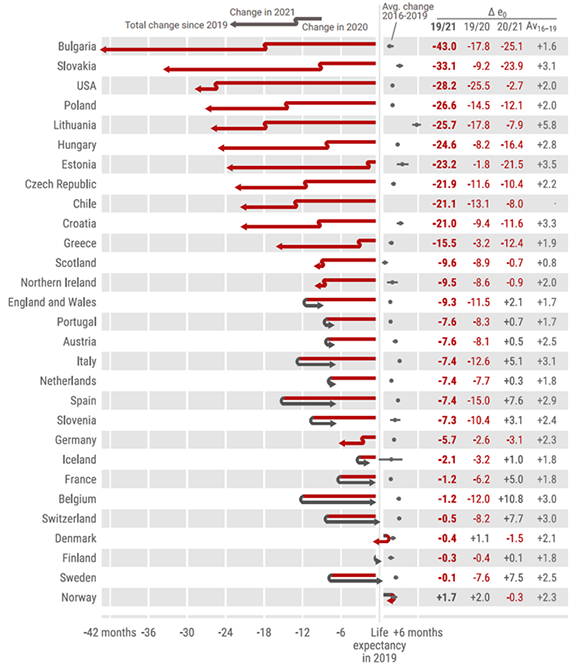
COVID-19 had least impact on life expectancy in Nordic countries
COVID-19 pandemic has led to life expectancy losses in Europe and overseas in the past two years but not in Denmark and its Nordic neighbours.
COVID-19 took a toll on human lives the last two years, but with different intensity across countries. Denmark is one of the few counties where mortality levels were very little affected and life expectancy did not bounce radically to better or worse over the past two years.
- On average, Danes were gaining a little more than two months of life expectancy yearly before the pandemic. In the first pandemic year 2020 the gain stayed positive although at somewhat lower level, 1,1 months, to turn slightly negative in 2021 to a 1,5-month loss in a year-to-year comparison, says José Manuel Aburto.
For a full overview see Figure 1.
Calm Danish waters
The calm Danish waters are rare.
A new study co-led by scientists at University of Southern Denmark found that countries spanning most of Europe, the US and Chile recorded reductions in life expectancy in 2020 at a scale that wiped out years of progress. Pandemics and other mortality shocks such as natural disasters negatively affect life expectancy. The nature, duration, and capacity to deal with the shock affects how fast will it take to rebound.
The COVID-19 death storm has had indeed different intensity and pace, the mortality trends in the second pandemic year 2021 saw more diverse impacts across countries.
Central and Eastern Europe most affected
While in 12 countries the tide started to return and the life expectancy saw bounce-backs from previous losses (among them most significantly Switzerland, Sweden, Spain, and Belgium), in another 14 countries the life expectancy storm continued and even intensified.
Good to know about life expectancy
Life expectancy, also known as period life expectancy, is a snapshot of current mortality conditions. It refers to the average age to which a newborn live if current death rates continued for their whole life. It does not predict an actual lifespan. It allows for a comparison of the size of the mortality impacts of the pandemic between different countries and populations.
- Central and Eastern European countries were the most affected and the impact of COVID-19 on mortality was much stronger than in 2020. USA with the worst life expectancy decline in the first year of pandemic did not rebound in 2021, says José Manuel Aburto.
Overall, the death toll of the two pandemic years reflects on how successfully countries managed the pandemic. In particular, how efficiently and diligently they managed lockdowns and vaccination. The lockdown timing and enforcement mattered a great deal.
What made the difference?
In the first pandemic year 2020, the countries with measured, timely and well-enforced lockdowns had the lowest excess death. In 2021, vaccine was available and countries that applied the vaccine fast and wide saw lower losses.
The structure of mortality changed over time, too. In 2021, more intense mortality of people below age 60 contributed largely to the life expectancy losses across countries, while older population saw mortality improvements compared to the first pandemic year 2020.
This is also associated to vaccination effectiveness. For example, while USA mortality for ages 80+ returned to pre-pandemic levels in 2021, overall life expectancy losses grew due to worsening mortality in ages below 60.
”Sweden and Switzerland managed to bounce back to pre-pandemic level of life-expectancy in the second year of the pandemic
Despite large differences, all countries under study experienced life expectancy deficits. Even the least affected countries, like Denmark, Finland, and Norway, experienced stagnation or slower improvement in life expectancy.
- Sweden and Switzerland managed to bounce back to pre-pandemic level of life-expectancy in the second year of the pandemic. Thus, together with the above-mentioned Nordic countries they also came out as the least affected overall, says José Manuel Aburto.
The research was published in Nature Human Behaviour and is a result of collaboration between the researchers of the Interdisciplinary Centre on Population Dynamics (CPop) at the University of Southern Denmark, the Max Planck Institute for Demographic Research, the Leverhulme Centre for Demographic Science (LCDS) at the University of Oxford, and the Estonian Institute for Population Studies at Tallin University. The study is supported by the ROCKWOOL Foundation.

How to read the Figure:
On the example of the USA:
Table part on the right hand side: Average increase in life expectancy for the years 2016-2019 in USA was +2.0 months (grey dot and the number in last column). Change in life expectancy between 2019 and 2021 (Δ e0 for column 19/21) was -28.2 months (a sum of Δ e0 19/20 and 20/21 column).
Graph part: The arm of the arrow represents the total life expectancy change between 2019 and 2021. The total change (Δ e0 19/21) is -28.2 months, composed of -25.5 months change between 19/20 and -2.7 month change between 20/21.
Meet the researcher
José Manuel Aburto is an Assistant Professor at the Interdisciplinary Centre on Population Dynamics, Odense, Denmark and a Marie-Curie Fellow at the Leverhulme Centre for Demographic Science, University of Oxford, Oxford, U.K.
Meet the researcher
Ilya Kashnitsky is an Assistant Professor at the Interdisciplinary Centre on Population Dynamics, Odense, Denmark.